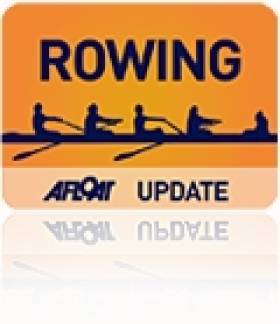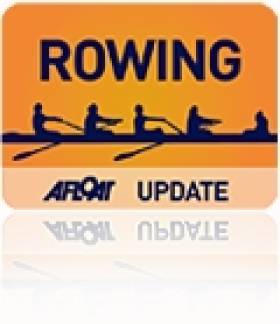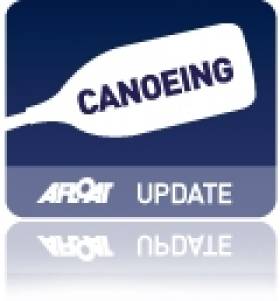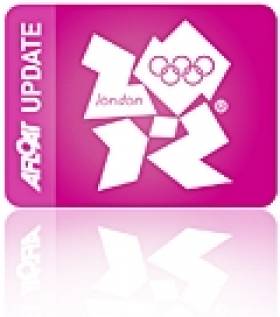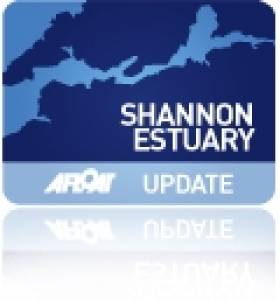Displaying items by tag: Olympic games
Afloat Rowers of the Year Announced
#Rowing: The Afloat Rowers of the Year for 2015 are the Ireland men’s and women’s lightweight double sculls who qualified their boats for the Olympic Games in 2016.
Claire Lambe and Sinéad Jennings needed to finish in the top 11 at the World Championships in Aiguebelette in August/September. They seemed well-placed in their semi-final to qualify for the A Final, but were pushed into fourth as Canada finished with a remarkable sprint. The Ireland crew changed tactics for the B Final, and it worked. They finished ninth.
The men’s lightweight double of Gary and Paul O’Donovan had a similar qualification mark in Aiguebelette. To have a shot they had to finish in the top three in their quarter-final, and they achieved this, pushing Hayden Cohen and Peter Taylor of New Zealand into fourth. They finished fifth in their semi-final and then booked their Rio place with a fifth-place finish (11th overall) in their B Final, eking out a place ahead of Greece, who had finished eighth at the Olympic Games in London.
Afloat wishes both crews and all the Irish rowing community the very best in 2016.
Rower of the Year Award: The judging panel is made up of Liam Gorman, rowing correspondent of The Irish Times and David O'Brien, Editor of Afloat magazine. Monthly awards for achievements during the year appeared on afloat.ie. The overall national award has been given to the crews who, in the judges' opinion, achieved the most notable results and made the most significant contribution to rowing during 2015. Keep an eye on progress in 2016.
Ireland Lightweight Doubles are Afloat Rowers of the Month
#Rowers of the Month: The Afloat Rowers of the Month for September are the Ireland men’s and women’s lightweight double sculls (Paul and Gary O’Donovan; Sinéad Jennings and Claire Lambe) which qualified their boats for the Olympic Games. Both crews faced challenges in their quest to be in the top 11 at the World Championships in Aiguebelette; both overcame them.
Jennings, a mother of three young children and a doctor, returned to the sport last year targeting a place in Rio. She broke a rib early this year. For another athlete this might have meant abandoning her punishing schedule. Jennings (then 38) redoubled her efforts. She excelled on the Wattbike at the Irish Indoor Championships and competed at the European Championships in a lightweight single. She came through a two-race trial to qualify for the lightweight double. Lambe and Jennings teamed up at the World Cup in Lucerne and finished seventh. It was a promising result, but this was their first time competing together. In the semi-final at the World Championships, they were outsprinted to the line by Canada, and missed out on an A Final spot. For the B Final, the tactics were to be in the leading group until the end. They did it. Their third place secured the precious slot in Rio for the Ireland women’s lightweight double.
Paul and Gary O’Donovan produced one of the greatest performances in Irish rowing by taking third place in their quarter final in Aiguebelette. With just a season of competition as a crew behind them, Gary (22) and Paul (21) were able to find a sprint finish which ousted New Zealand from a chance of qualifying their boat. In the B Final, the O’Donovan brothers stayed with the leaders until the finishing sprint, where they showed tremendous grit to take fifth (11th overall), .28 of a second ahead of Greece.
Well done to all the Ireland team and to the two crews which are the Afloat Rowers of the Month.
Rower of the Month awards: The judging panel is made up of Liam Gorman, rowing correspondent of The Irish Times and David O'Brien, Editor of Afloat magazine. Monthly awards for achievements during the year will appear on afloat.ie and the overall national award will be presented to the person or crew who, in the judges' opinion, achieved the most notable results in, or made the most significant contribution to rowing during 2015. Keep a monthly eye on progress and watch our 2015 champions list grow.
Liam Jegou Excels in Second Run to Claim Semi-Final Place at World Championships
#Canoeing: Liam Jegou qualified for the semi-final of the canoe slalom World Championships in Lee Valley, England today. The France-based teenager produced an impressive, penalty-free, second run in the C1 to place ninth, with 10 places available. In his first run, he incurred penalties on gates eight and 11 and had four seconds in penalties, but would have fallen outside qualification in any case. Jake Cochrane placed 68th and 64th in his two runs.
Canoe Slalom World Championships, Lee Valley, London, Day Two (Irish interest)
Men
C1 – First Run (top 20 to semi-finals): 37 L Jegou 95.98 seconds (incl 4 sec pen); J Cochrane 161.15 (incl 54 sec pen). Second Run (10 qualify): 9 Jegou 90.83; 64 Cochrane 108.38 (incl 8 sec pen).
Women
C1 – First Run (top 15 to semi-finals) 32 C O’Ferrall 191.62; Second Run: O’Ferrall 132.14 (incl 4 sec pen)
Puspure and Jegou Receive Rio Scholarships
#ROWING: Sanita Puspure and canoeist Liam Jegou are among eight athletes who have been chosen by the Olympic Council of Ireland as recipients of Rio Scholarship programmes. The recipients will be supported from a fund of over €100,000 which comes courtesy of the OCI in association with the International Olympic Committee’s solidarity programme.
Jegou took silver at the Canoe Slalom Junior World Championships this year and was fourth at the European Junior Championships.
Puspure, a single sculler, took fourth place at the World Rowing Championships and a bronze medal at the European Championships. In her World Cup campaign, she made the A Final in Aiguebelette, and won the B Final at Lucerne.
The full list of athletes receiving scholarships is: Chloe and Sam Magee (badminton mixed doubles): Sanita Puspure (rowing); Liam Jegou (slalom canoeing), Bryan Keane (triathlon), Lisa Kearney (judo), Andrew Smith (gymnastics) and Natalya Coyle (modern pentathlon).
Espersen Sees Three Ireland Women's Boats at Rio 2016
#ROWING: The annual general meeting of Rowing Ireland at Garda Boat Club today was told my Morten Espersen, the High Performance Director, that he expected to send at least three women’s boats to the Olympic Games in Rio de Janeiro in 2016. The two motions before the meeting were passed by assent: Just Sport Ireland will be adopted as the final arbitrator in grievance procedures and the agm may be called at any time through the year.
The meeting was concluded in an hour.
Branch Awards
Connacht: Mike McCrohan, Tribesmen
Leinster: Niall O’Toole, Commercial
Ulster: Gordon Reid, Lagan Scullers’
Munster: Mary Bonner, Tralee
President’s Prize: Dominic Casey, Skibbereen
Olympic Canoeist Eoin Rheinisch Bows Out
#CANOEING: Eoin Rheinisch, a three time Ireland Olympian in canoe slalom, has retired.
In a statement, the Kildare man looked back over his career.
In 1996, I watched the Atlanta Olympics with my brothers at our home in Leixlip. Inspired by my sporting heroes expertly negotiating the coloured poles hanging down over the heaving white water, I made a decision that would shape the rest of my life. I wanted to represent Ireland at an Olympic Games. The past 18 years of chasing that dream - and other related goals - have been an incredible experience but the time has come for me to move on to the next chapter of my life.
I have given the decision to retire much thought and it is not an easy thing to do. I also considered allowing retirement to drift past unannounced. But I wanted to highlight what sport has done for me and thank all of the wonderful people that have helped me throughout my career.
During the incredible 90 seconds of a slalom race, I am on my own to face down those coloured poles and heaving water. But the preparation to reach that stage has involved commitment and support from sporting bodies and countless individuals at every stage of my career. This has been an all-consuming pursuit involving full-time training and travel outside of Ireland for more than 200 days a year.
That type of commitment would not have been possible without the support of the Irish Sports Council, Irish Institute of Sport, Olympic Council of Ireland, Canoeing Ireland and the various private sponsors that have believed in me.
Over the years, my sporting idols have changed but my real deserved heroes are my parents, brothers, close friends and partner. This career choice and what it involves can often be a selfish pursuit and, despite this, they have always been there for me no matter how bad the outlook is. I don't say it often enough ... "thank you".
I have been so fortunate to have the gift of good health that has allowed me to have such a long sporting career. My parents, my own injuries and illnesses along the way have taught me to never take this gift for granted. Representing Ireland at three Olympic Games has been an honour and a privilege. Finishing 4th in Beijing was a standout moment. Coming through under extreme pressure is one of the most exhilarating feelings I know. My own personal highlight was winning a World Cup in Spain during the selection process for the Athens Olympics.
Every highlight had plenty of accompanying lows, which were a necessary part of my development. Overcoming obstacles and responding well to dips in performance have helped shape the type of person I am today.
I am still involved in high-performance sport thanks to the education provided by the Institute's Pursuit of Excellence Programme. I want to pass my experience on to the current crop of junior and under 23 athletes and have already started working with them. I have no doubt that future Olympians will emerge from this inspirational group of youngsters.
I am sure there are even more challenges in the future and I hope to use both my sporting experience and formal education, including a degree in Business and Marketing, as I face them down.
Karl Dunne of Canoeing Ireland said: "Eoin has been a great ambassador for the sport of canoeing throughout his career, my overriding impression of Eoin has always been one of professionalism. While he may be hanging up his competitor paddles, Canoeing Ireland are delighted that there is real legacy in Eoin taking up the position as National Coach to the U23 and Junior Canoe Slalom Squads. For the first time in the organisations history we have a true home grown high performance coach . On behalf of all at Canoeing Ireland, I wish Eoin the very best of luck as he moves from the water to the riverbank".
Pat Hickey, President Olympic Council of Ireland and IOC executive Member, said: "Eoin has been a great ambassador for canoeing and for Olympism. I followed his career with interest since he first came to our attention and his 4th place at the Beijing Olympic Games is just one of the many highlights along the way. His training, preparation and attitude has always been most professional and he is a terrific role model for the next generation. I wish him well for the future".
John Treacy, CEO, Irish Sports Council, added: "Eoin is one of the outstanding Irish athletes of his generation. He has had a great career, one we were proud to support. More than that, he is a true gentleman and has always been a pleasure to work with, a professional in every aspect of his preparation and performance. On behalf of the Council I want to wish him well in his retirement from international sport".
Eoin Rheinisch's Main Achievements:
· 3 Time Irish Olympian – Athens 2004, Beijing 2008, London 2012.
· 4th Place at the Beijing Olympics
· World Cup Gold Medallist – La Seu D'Urgell, Spain.
· European and World Championship Finalist.
· 7 Time World Cup Finalist
James Espey Profile
James Espey became the fourth Irish sailing campaign to qualify for the London Olympics.
Sailing since the young age of ten, his first national championship title result not in a single-handed class but in the five man 1720 sportsboat class in 1998 but solo sailing has always been the attraction for the Ulsterman. As the number one ranked Irish Laser sailor Espey previously missed the cut last December when a black flag disqualification cost him dearly at the Auckland ISAF World championships but the plucky Belfast Lough sailor took a personal best of 37th overall in May's Laser Worlds in Germany to secure his Olympic debut in Weymouth.
Name: James Espey
Hometown: Bangor, Northern Ireland
Club: Royal Ulster Yacht Club/Ballyholme YC
Age: 28
Discipline: Laser dinghy
World Ranking: 92nd (May 2012)
British Sailing Academy at Weymouth Enhances Business
#olympic sailing – The Weymouth and Portland National Sailing Academy is primarily renowned for its status as an Olympic sailing venue and was described by Seb Coe as 'the ultimate water sports venue'. Now following up on the great success of the British Business Pavilion held at the Qinetic site at Bincleaves during the Olympic sailing events, the Academy is also providing an iconic setting for a wide range of business events.
Weymouth and Portland Chamber of Commerce know the value of hosting events at the venue and have described the Academy as "an outstanding place to create business and showcase Dorset as a fantastic place to visit."
The Academy is able to cater for seminars or meetings of up to 200 people in the 'Spinnakers Room' and has a series of smaller rooms suitable for between 10 and 70 people. With locally sourced catering and very extensive free car parking, the Academy provides a unique local opportunity to have that special business meeting and networking in an Olympic venue with all the associated values of excellence, respect and friendship. The main rooms have a stunning view of the Jurassic Coast with an extensive balcony overlooking the race areas and Dinghy Park. A range of water sports can also be arranged to form part of the programme if required, so that a real team building event can be delivered.
Furthermore, having won a series of very prestigious awards, the venue is rightfully proud of its environmental credentials. It is one of the few venues to have achieved accreditation under International Standard ISO 20121 for its sustainable management system for events – a standard developed for the 2012 Games and now being implemented internationally.
Mike Rundle from UKTI South West believes that WPNSA can add the wow factor to any business meeting or event: "The Weymouth and Portland National Sailing Academy in Portland stands unique in UK sport being one of the few Olympic venues that will continue to be used as a National Sports Centre post the 2012 Games. The view of other national teams who used the facilities in both the run up to 2012 and during the competition was overwhelming in the opinion that Weymouth and Portland represents the best designed facilities for competition sailing in the world and is a model for any Sailing Federation seeking to develop their own National Academy.
As a venue it is unrivalled in its setting. Majestic on days with bright blue skies, broody and daunting in stormy weather, the Academy delivers on so many different levels, contributing drama and character to any event being held in its flexible and impressive reception rooms. Little more than a decade since it opened its doors in 2000, the Academy has already absorbed the tradition of British sailing history and possesses that indefinable sense of presence which adds to the atmosphere.
WPNSA rightly holds a unique and special place in Dorset making it the pre-eminent venue for any business conference to be held in the region and UKTI views the Academy as the only place we wish to hold our events in the area due to the international pedigree and facilities the Academy offers us."
Olympic Games Rio 2016
The 2016 Summer Olympics, officially known as the Games of the XXXI Olympiad, is a major international multi-sport event due to be celebrated in the tradition of the Olympic Games, as governed by the International Olympic Committee (IOC). The host city of the Games will be Rio de Janeiro, Brazil. They are scheduled to be held from August 5 to 21, 2016, making these the first Summer Olympics to be held during the host city's winter. There will be 30 competition venues mainly in Barra da Tijuca, but also in three other zones: Copacabana, Deodoro, and Maracanã. It will mark the first time a South American city hosts the event, the first to host the hemisphere's winter, and also the first time a Lusophone (Portuguese-speaking) country hosts the event.
London 2012 Weighs Anchor off World Famous Golf Course
#OLYMPIC SHIP - A 82,562 dwt dry bulk-carrier, London 2012, weighed anchor today having recently docked at the Aughinish Alumina jetty, on the Shannon Estuary, writes Jehan Ashmore.
The Liberian flagged vessel which has a draft of more than 14m had docked at Aughinish, one of six terminals operated by Shannon Foynes Port Co, near Askeaton, Co. Limerick. The facility is where large sized ships can reach by plying the deep waters of the mid-western waterway that has some 500sq km of navigable estuary.
Following completion of operations of London 2012 at the Aughinish terminal, which is the largest alumina refinery in Europe, the vessel departed the jetty dedicated to importing bauxite to the Russian owned RUSAL plant, and proceeded to anchorage beyond the mouth of the Shannon.
The 229m long X 32m beam vessel had anchored some 3 nautical miles offshore of Ballybunion. The west Kerry venue is another place strongly associated with sport through its world famous golf course, situated on a spectacular stretch of coastline overlooking the Atlantic Ocean.
London 2012 and her sister Beijing 2008, belong to a fleet of approximately 70 vessels, totalling a capacity of 8 million deadweight tons (dwt) and are managed by Tsakos Columbia Shipmanagement (TCM) S.A. of Greece.
The Athens based TCM was only established in July 2010, as a joint venture between Tsakos Shipping and Trading S.A. and Schoeller Holdings Ltd, the owner and operator of Columbia Shipmanagement Ltd.
No doubt her Greek owners will make an opportunity for a vessel to continue in the Olympic spirit by sporting the name Rio de Janeiro 2016. As for golf fans, they too can look forward to the return of the sport in these Games.



























